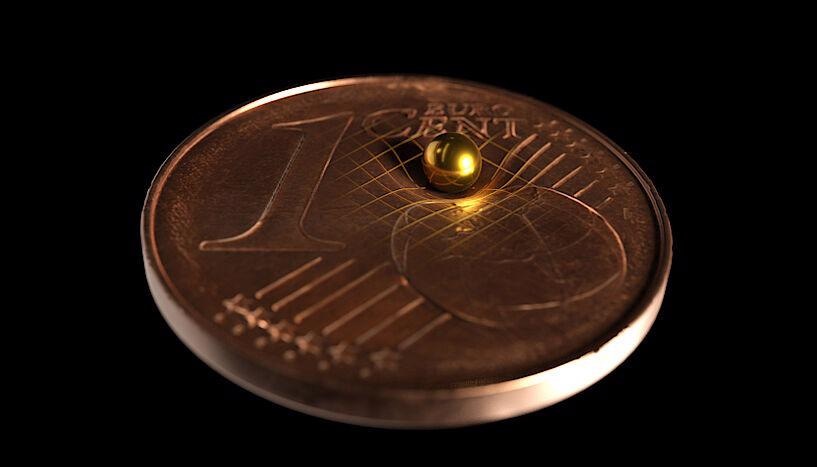Mar 11 2021
Using a highly sensitive pendulum, scientists have successfully determined the gravitational field of a gold sphere, measuring only 2 mm in diameter, and thus, the smallest gravitational force to date.
 The gold ball used in size comparison with a 1 cent coin. According to Einstein's general theory of relativity, every mass bends space-time. Image Credit: © Tobias Westphal/Arkitek Scientific.
The gold ball used in size comparison with a 1 cent coin. According to Einstein's general theory of relativity, every mass bends space-time. Image Credit: © Tobias Westphal/Arkitek Scientific.
The team included researchers from the University of Vienna and the Austrian Academy of Sciences, headed by Markus Aspelmeyer. This latest experiment provides new possibilities for testing the laws of gravity on formerly unachieved small scales. The results of the study have been published in the Nature journal.
The weakest of all familiar forces in nature is gravity, and yet it is the strongest one present in people’s daily lives. Every coin that is dropped and every ball that is thrown are all objects that are pulled by the gravity of the Earth.
In the case of a vacuum, all objects that are close to the surface of the Earth fall with the same level of acceleration: the velocity of these objects increases by around 9.8 m/second.
The Earth’s mass and the distance from the core determine the strength of gravity. On the Moon, which is nearly four times smaller and approximately 80 times lighter than the Earth, all objects fall six times slower.
So, what would be the outcome on a planet that is the size of a ladybug? Evidently, objects would fall 30 billion times slower on this tiny planet than on Earth. This level of gravitational forces usually takes place only in the most remote areas of galaxies to couture distant stars.
Now, for the first time, a group of quantum physicists, headed by Markus Aspelmeyer and Tobias Westphal from the University of Vienna and the Austrian Academy of Sciences, has demonstrated these gravitational forces in laboratory settings.
To achieve this, the investigators took a cue from a popular experiment performed by Henry Cavendish toward the end of the 18th century.
During the period of Isaac Newton, it was assumed that gravity was relevant only to astronomical objects, including planets.
But the research work of Cavendish (and Nevil Maskelyne prior to him) eventually revealed that it is possible to show that gravity is also created by the objects on Earth.
With the help of a unique pendulum device, Cavendish effectively quantified the gravitational force produced by a lead ball weighing 160 kg and measuring 30 cm tall in 1797.
The gravitational force of the lead mass significantly deflects a so-called torsion pendulum—a pair of masses at the ends of a rod that is suspended from a thin wire and rotates freely. Over the forthcoming centuries, such experiments were additionally perfected to quantify the gravitational forces with more precision.
This concept was leveraged by the Vienna research team, who went on to create a tiny model of the Cavendish experiment. A gold sphere, weighing 90 mg and measuring 2 mm, acts as the gravitational mass.
The torsion pendulum contains a glass rod measuring 0.5 mm thick and 4 cm long, suspended from a glass fiber that has a diameter of a few thousandths of a millimeter. Gold spheres of analogous size were fixed to both ends of the glass rod.
“We move the gold sphere back and forth, creating a gravitational field that changes over time. This causes the torsion pendulum to oscillate at that particular excitation frequency,” explained Jeremias Pfaff, one of the investigators who took part in the experiment.
The movement, which measures just a few millionths of a millimeter, can be subsequently read out using a laser and helps to conclude about the force. The challenge is to keep other effects on the movement as small as possible.
The largest non-gravitational effect in our experiment comes from seismic vibrations generated by pedestrians and tram traffic around our lab in Vienna. We therefore obtained the best measurement data at night and during the Christmas holidays, when there was little traffic.
Hans Hepach, Study Co-Author, University of Vienna
Other effects, like electrostatic forces, could be decreased to levels that are much below the gravitational force through a conductive shield between the gold masses.
For the first time, this made it feasible to find out the gravitational field of an object that has about the mass of a ladybug. As the following step, the team has planned to analyze the gravity of masses that are many times lighter.
The prospect of quantifying gravitational fields of tiny masses and at close distances provides new perspectives for studies in gravitational physics; signs of dark energy or dark matter could be detected in the gravitational behavior, which may account for the development of the current universe.
Aspelmeyer’s research team is specifically keen on the interface with quantum physics: could the mass be made sufficiently small for quantum effects to play a key role? Only time will tell. At present, the attraction toward Einstein’s theory of gravity continues to prevail.
According to Einstein, the gravitational force is a consequence of the fact that masses bend spacetime in which other masses move. So what we are actually measuring here is, how a ladybug warps space-time.
Tobias Westphal, Study First Author, University of Vienna
Journal Reference:
Westphal, T., et al. (2021) Measurement of gravitational coupling between millimetre-sized masses. Nature. doi.org/10.1038/s41586-021-03250-7.